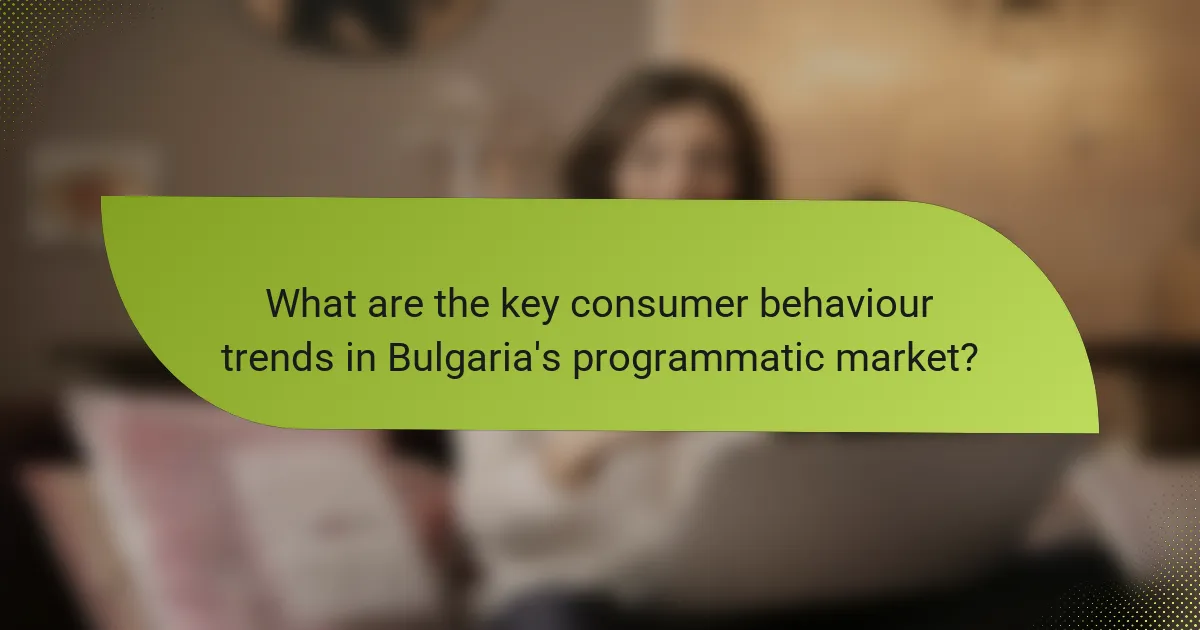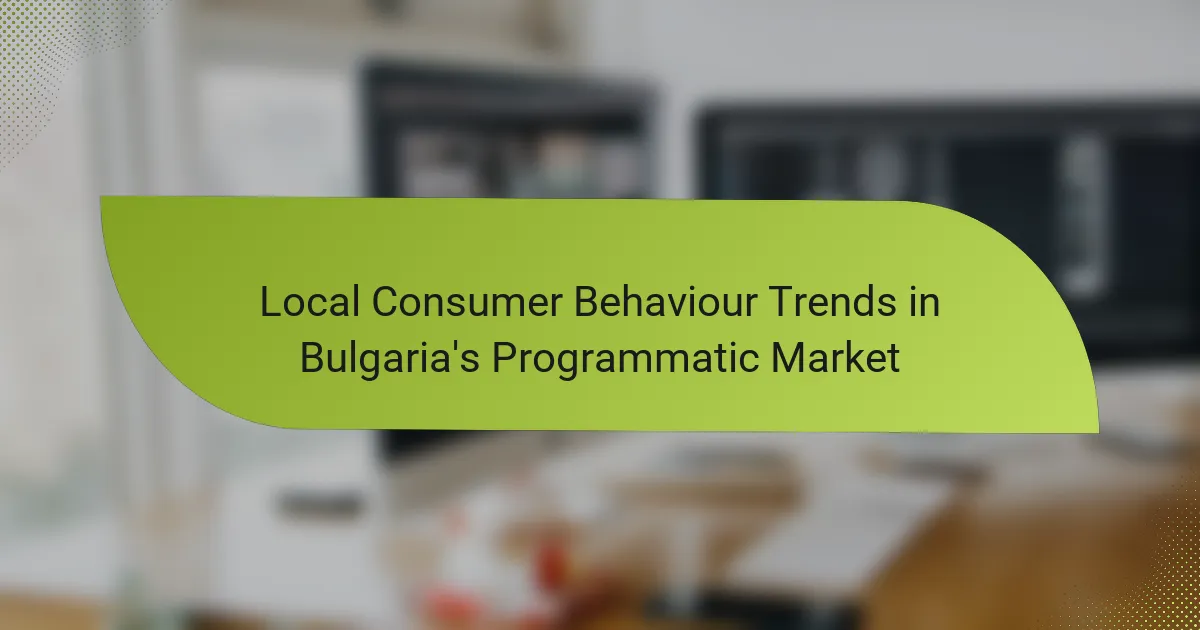The programmatic market in Bulgaria is experiencing notable shifts in consumer behaviour, characterised by a rise in mobile usage and a strong preference for personalised advertising. As video content consumption grows, there is also a marked inclination towards eco-friendly brands and the influence of social media on purchasing decisions. Understanding local cultural nuances and addressing challenges such as data privacy and digital literacy are crucial for advertisers aiming to connect effectively with Bulgarian consumers.

What are the key consumer behaviour trends in Bulgaria’s programmatic market?
Key consumer behaviour trends in Bulgaria’s programmatic market include increased mobile usage, a strong preference for personalised ads, and a notable growth in video advertising consumption. Additionally, consumers are shifting towards eco-friendly brands and are increasingly influenced by social media platforms.
Increased mobile usage
Mobile usage in Bulgaria’s programmatic market has surged, with a significant portion of consumers accessing content primarily through smartphones. This trend necessitates that advertisers optimise their campaigns for mobile devices to effectively reach their target audience.
Brands should consider mobile-friendly formats such as responsive ads and ensure fast loading times to enhance user experience. Ignoring mobile optimisation can lead to decreased engagement and higher bounce rates.
Preference for personalised ads
Bulgarians are increasingly favouring personalised ads that cater to their specific interests and preferences. This trend highlights the importance of leveraging data analytics to understand consumer behaviour and tailor advertising strategies accordingly.
Advertisers should utilise programmatic tools to segment audiences and deliver relevant content, enhancing the likelihood of conversion. Failing to personalise ads may result in lower engagement and wasted ad spend.
Growth in video advertising consumption
Video advertising consumption is on the rise in Bulgaria, driven by the popularity of platforms like YouTube and social media. Consumers are more likely to engage with video content, making it a vital component of programmatic advertising strategies.
Brands should invest in high-quality video production and consider short, impactful formats to capture attention quickly. Ignoring video as a medium may lead to missed opportunities in reaching a broader audience.
Shift towards eco-friendly brands
There is a growing trend among Bulgarian consumers to support eco-friendly brands that prioritise sustainability. This shift is influencing purchasing decisions and brand loyalty, making it essential for advertisers to highlight their commitment to environmental responsibility.
Brands can enhance their appeal by showcasing sustainable practices in their advertising campaigns. Neglecting to address eco-consciousness may alienate a significant segment of the market.
Rising influence of social media
Social media platforms are playing an increasingly influential role in shaping consumer behaviour in Bulgaria’s programmatic market. Consumers often rely on social media for product recommendations and brand interactions.
Advertisers should engage with audiences on platforms like Facebook and Instagram, utilising targeted ads and influencer partnerships to enhance visibility. Ignoring social media dynamics can limit brand reach and consumer engagement.

How does local culture influence programmatic advertising in Bulgaria?
Local culture significantly shapes programmatic advertising in Bulgaria by prioritising community connections and the use of the Bulgarian language. Advertisers must consider these cultural nuances to effectively engage with consumers and drive conversions.
Emphasis on community values
Bulgarians place a strong emphasis on community, which influences their consumer behaviour. Advertisements that highlight local traditions, social responsibility, and community involvement tend to resonate more with the audience.
Brands can enhance their programmatic strategies by showcasing local partnerships or supporting community initiatives. For example, a campaign that promotes a local charity event can foster goodwill and strengthen brand loyalty among consumers.
Importance of local language in ads
Using the Bulgarian language in advertisements is crucial for effective communication. Consumers are more likely to engage with content that feels relatable and culturally relevant, which often means using their native language.
Programmatic ads that incorporate local dialects or colloquial expressions can create a stronger emotional connection. Brands should ensure that their messaging is not only translated but also culturally adapted to reflect local nuances and preferences.

What are the challenges in targeting Bulgarian consumers programmatically?
Targeting Bulgarian consumers programmatically presents several challenges, including navigating data privacy regulations and addressing limited digital literacy, particularly in rural areas. These factors can significantly impact the effectiveness of programmatic advertising strategies.
Data privacy regulations
Data privacy regulations in Bulgaria, aligned with the EU’s General Data Protection Regulation (GDPR), impose strict guidelines on how consumer data can be collected and used. Advertisers must ensure compliance by obtaining explicit consent from users before processing their personal information.
Failure to adhere to these regulations can result in hefty fines and damage to brand reputation. It’s essential for marketers to implement transparent data practices and provide clear information about how consumer data will be utilised.
Limited digital literacy in rural areas
Limited digital literacy in Bulgaria’s rural areas poses a significant barrier to effective programmatic targeting. Many consumers in these regions may lack familiarity with online platforms, reducing their engagement with digital ads.
To overcome this challenge, advertisers should consider tailored strategies that resonate with local audiences. This could include using simpler messaging, focusing on mobile-friendly formats, and leveraging local influencers to build trust and familiarity with digital advertising.

What strategies can advertisers use to engage Bulgarian consumers?
Advertisers can effectively engage Bulgarian consumers by utilising local influencers, implementing geo-targeted campaigns, and leveraging user-generated content. These strategies help create a more personalised experience that resonates with the local audience.
Utilising local influencers
Collaborating with local influencers can significantly enhance brand visibility and credibility in Bulgaria. Influencers often have established trust with their followers, making their endorsements more impactful than traditional advertising methods.
When selecting influencers, consider their audience demographics and engagement rates. Micro-influencers, who typically have smaller but highly engaged followings, can be particularly effective for niche markets.
Implementing geo-targeted campaigns
Geo-targeted campaigns allow advertisers to deliver tailored messages to consumers based on their geographic location. This strategy is particularly effective in Bulgaria, where regional preferences can vary widely.
To implement geo-targeting, use data analytics tools to identify key areas and demographics. Consider offering localised promotions or content that reflects regional culture and interests to increase relevance and engagement.
Leveraging user-generated content
User-generated content (UGC) can foster community and enhance brand loyalty among Bulgarian consumers. Encouraging customers to share their experiences with your products can provide authentic testimonials that resonate with potential buyers.
To effectively leverage UGC, create campaigns that incentivise sharing, such as contests or giveaways. Highlighting customer stories on social media or your website can also enhance trust and encourage new customers to engage with your brand.

What metrics should be prioritised in Bulgaria’s programmatic campaigns?
In Bulgaria’s programmatic market, prioritising metrics such as click-through rates, conversion rates, and return on ad spend is essential for optimising campaign performance. These metrics provide insights into audience engagement, effectiveness of ads, and overall profitability.
Click-through rates
Click-through rates (CTR) measure the percentage of users who click on an ad after seeing it. A higher CTR indicates that the ad is engaging and relevant to the target audience. In Bulgaria, aim for a CTR of around 1-3% as a benchmark, but this can vary based on industry and ad placement.
To improve CTR, focus on creating compelling ad copy and visually appealing designs. A/B testing different ad formats can also help identify what resonates best with your audience.
Conversion rates
Conversion rates reflect the percentage of users who complete a desired action after clicking on an ad, such as making a purchase or signing up for a newsletter. In Bulgaria, a good conversion rate typically ranges from 2-5%, depending on the industry and campaign goals.
To enhance conversion rates, ensure that landing pages are optimised for user experience and aligned with the ad’s message. Implementing clear calls to action and minimising page load times can significantly boost conversions.
Return on ad spend
Return on ad spend (ROAS) measures the revenue generated for every unit of currency spent on advertising. A ROAS of at least 4:1 is often considered a good target in Bulgaria’s market, meaning for every 1 BGN spent, 4 BGN in revenue should be generated.
To maximise ROAS, continually analyse campaign performance and adjust bidding strategies accordingly. Focus on high-performing segments and consider reallocating budget from underperforming ads to those with better returns.

How does programmatic advertising pricing work in Bulgaria?
Programmatic advertising pricing in Bulgaria typically operates on a real-time bidding (RTB) model, where advertisers bid for ad placements in real-time. The costs can vary based on factors such as audience targeting, ad formats, and competition for inventory.
Key pricing models in programmatic advertising
The primary pricing models used in Bulgaria’s programmatic market include Cost Per Mille (CPM), Cost Per Click (CPC), and Cost Per Acquisition (CPA). CPM is the most common, where advertisers pay for every thousand impressions served, while CPC charges for each click on the ad, and CPA is based on the actual conversion or sale.
Advertisers should consider their campaign goals when choosing a pricing model. For brand awareness, CPM might be more suitable, whereas CPC or CPA could be better for performance-driven campaigns.
Factors influencing programmatic pricing
Several factors influence programmatic advertising pricing in Bulgaria, including audience demographics, ad placement quality, and seasonal demand. High-demand periods, such as holidays or major events, can drive prices up significantly.
Additionally, the quality of the inventory plays a crucial role. Premium placements on well-known websites typically command higher prices than less reputable sites. Advertisers should analyse their target audience and select inventory that aligns with their campaign objectives.
Tips for managing programmatic advertising costs
To effectively manage costs in programmatic advertising, advertisers should set clear budgets and monitor performance closely. Utilise data analytics to optimise campaigns in real-time, adjusting bids based on performance metrics.
It is also advisable to test different pricing models and strategies to find the most cost-effective approach. Avoid overspending by setting bid limits and using frequency capping to prevent ad fatigue among users.



